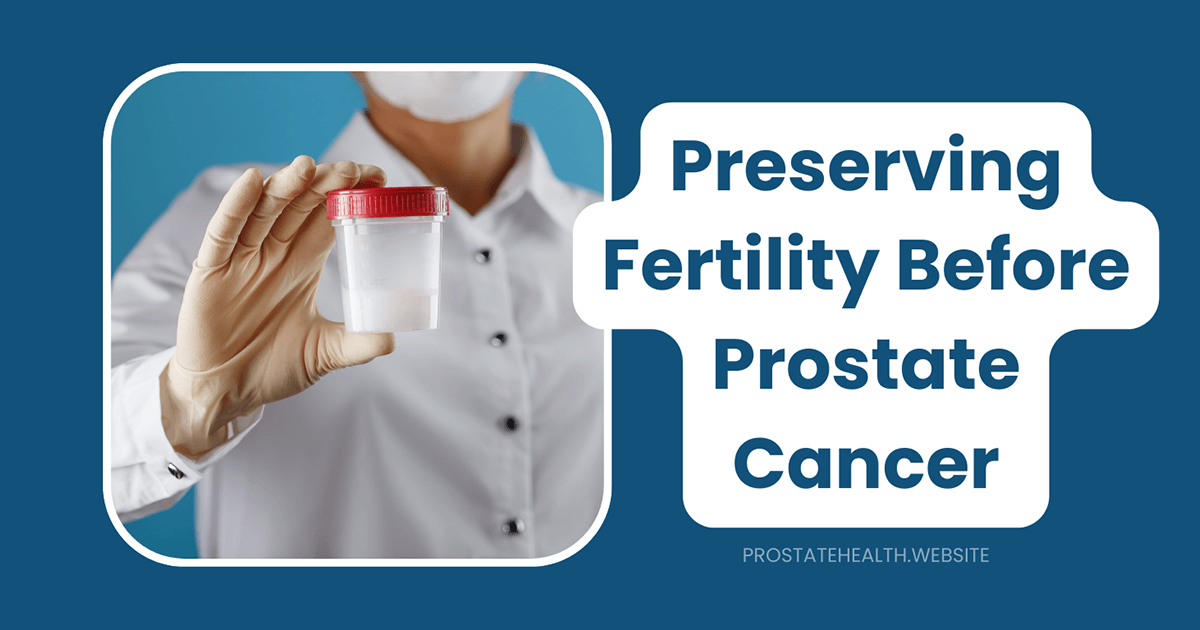Fertility Preservation Options Before Prostate Cancer Treatment

When 45-year-old Michael was diagnosed with prostate cancer, his first thoughts were about survival. But as his oncologist outlined treatment options, another reality hit him: the treatments that might save his life could also end his chances of having biological children.
“My wife and I had been trying for our second child,” Michael recalls. “Suddenly, I was facing not only cancer but the possibility that our family plans would have to change forever.”
Michael’s situation isn’t uncommon. While prostate cancer often affects older men, approximately 10% of cases occur in men under 55—many of whom may still want to father children. The good news? With advance planning, fertility preservation options can keep the door open for future fatherhood, even after cancer treatment.
Why Prostate Cancer Treatment Affects Fertility
Before exploring preservation options, it’s important to understand how prostate cancer treatments impact fertility:
Surgical Treatments
Radical prostatectomy—the surgical removal of the prostate gland—directly affects fertility in several ways:
- Removes the prostate and seminal vesicles, which produce semen
- Can damage nerves necessary for ejaculation
- Results in “dry orgasm” where climax occurs without ejaculation
- Makes natural conception impossible even if sperm production continues
As Dr. James Wilson, urologist at Memorial Sloan Kettering Cancer Center, explains: “After radical prostatectomy, men still produce sperm in their testicles, but there’s no way for that sperm to exit the body during ejaculation because the pathway is surgically interrupted.”
Radiation Therapy
Radiation treatments can affect fertility through:
- Direct damage to sperm-producing cells in the testicles (if they’re in the radiation field)
- Damage to the prostate and surrounding tissues that contribute to semen
- Potential long-term reduction in sperm count and quality
- Increased risk of genetic damage to sperm during and shortly after treatment
Hormone Therapy
Androgen deprivation therapy (ADT) works by dramatically reducing testosterone levels, which:
- Decreases sperm production
- Reduces sexual desire and function
- May cause temporary or permanent infertility depending on treatment duration
- Can take months or years to reverse after treatment ends
Fertility Preservation Options: Planning Ahead
The key to preserving fertility is taking action before cancer treatment begins. Here are the primary options available:
Sperm Banking (Cryopreservation)
Sperm banking is the most established, effective, and widely available fertility preservation method for men facing prostate cancer treatment.
How It Works
- Semen samples are collected through masturbation, partner stimulation, or vibratory stimulation devices
- The sample is analyzed for sperm count, motility (movement), and morphology (shape)
- The sperm is mixed with a cryoprotectant solution to prevent damage during freezing
- Samples are frozen and stored in liquid nitrogen at -196°C (-320°F)
- When needed, sperm can be thawed and used for intrauterine insemination (IUI) or in vitro fertilization (IVF)
“I banked three samples before starting treatment,” shares Thomas, 52, who underwent radical prostatectomy. “The process was straightforward—much easier than I expected. It gave me peace of mind knowing I had that option for the future.”
Success Rates and Considerations
- Sperm can be stored indefinitely—successful pregnancies have been reported from samples frozen for up to 30 years
- Even samples with low sperm count or quality can be used with advanced reproductive techniques like intracytoplasmic sperm injection (ICSI)
- Multiple samples (ideally collected a few days apart) provide more options for future use
- The process is quick and can usually be completed within a week, rarely delaying cancer treatment
Testicular Sperm Extraction (TESE)
For men who cannot ejaculate or have very low sperm counts in their ejaculate, surgical sperm retrieval may be an option:
- Performed under local or general anesthesia
- Involves removing small pieces of testicular tissue
- Sperm are extracted from the tissue in the laboratory
- The retrieved sperm can be frozen or used immediately for IVF with ICSI
“After my diagnosis, I discovered I had very low sperm count due to the cancer itself,” explains Robert, 48. “TESE allowed me to preserve some sperm before treatment began.”
Radiation Shielding
For men undergoing radiation therapy, special shields can sometimes protect the testicles:
- Lead shields are placed over the testicles during treatment
- Reduces (but doesn’t eliminate) radiation exposure to sperm-producing cells
- Most effective when the radiation target is distant from the testicles
- May be used in combination with sperm banking for added protection
Timing Is Everything: When to Preserve Fertility
The window for fertility preservation is narrow and specific:
- Ideally before any treatment begins: Even diagnostic procedures and medications can temporarily affect sperm quality
- As soon as possible after diagnosis: Stress and the cancer itself can impact sperm parameters
- With enough time for multiple collections: Collecting 2-3 samples provides better options for future use
Dr. Sarah Chen, reproductive endocrinologist, emphasizes: “The conversation about fertility preservation should happen at diagnosis, before treatment planning is finalized. Unfortunately, studies show that only about 8.7% of localized prostate cancer patients are informed about fertility risks before treatment.”
Costs and Insurance Coverage
Understanding the financial aspects of fertility preservation is important:
Typical Costs
- Initial sperm banking: $500-$1,000 per collection
- Annual storage fees: $150-$500
- TESE procedure: $6,000-$15,000
- Future use for IUI or IVF: Additional costs ranging from $1,000-$20,000+
Insurance Coverage
- Coverage varies widely by provider and state
- Some states have fertility preservation mandates for cancer patients
- Many insurance plans do not cover storage fees
- Organizations like LIVESTRONG Fertility offer financial assistance programs
“The cost was initially concerning,” admits Carlos, 50. “But when I compared it to the overall cost of cancer treatment—and the value of potentially having children in the future—it was an easy decision to make.”
Making the Decision: Is Fertility Preservation Right for You?
Several factors may influence your decision about fertility preservation:
Age and Life Stage
While prostate cancer typically affects older men, younger patients have different considerations:
- Men under 50 are more likely to benefit from preservation
- Research shows that men who are childless or desire more children are more interested in sperm banking
- Even men in their 60s may choose preservation if they have younger partners or future family plans
Current Family Status
Your existing family situation plays a role:
- Men without children may prioritize preservation
- Those with complete families might still preserve for peace of mind
- Partners’ perspectives and family planning goals are important considerations
Cancer Severity and Treatment Urgency
Sometimes treatment timing affects preservation options:
- High-risk cancers may require immediate treatment
- Low or intermediate-risk cancers might allow more time for preservation
- Treatment choices (surgery vs. radiation vs. active surveillance) have different fertility impacts
Personal Values and Beliefs
Individual perspectives on biological parenthood vary:
- Some men strongly desire genetic connection to future children
- Others are open to alternative family-building options like adoption
- Religious or cultural beliefs may influence decisions about assisted reproduction
Beyond Sperm Banking: Alternative Family-Building Options
If fertility preservation isn’t possible or successful, other pathways to parenthood exist:
Donor Sperm
- Used with partner’s eggs through IUI or IVF
- Carefully screened for genetic and infectious diseases
- Can be selected based on physical characteristics and background
Adoption
- Domestic or international options
- Can involve newborns or older children
- Private or agency-facilitated processes
Foster Parenting
- Temporary or permanent care options
- Opportunity to help children in need
- Can sometimes lead to adoption
“After my treatment, we discovered my banked sperm wasn’t viable,” shares William, 55. “We ultimately adopted our son, who’s now 10. While it wasn’t our original plan, I can’t imagine our family any other way.”
Having the Conversation: Talking to Your Healthcare Team
Advocating for your fertility is crucial, as many healthcare providers may not initiate the conversation:
Questions to Ask Your Oncologist
- How might each treatment option affect my fertility?
- Can treatment be delayed briefly for fertility preservation?
- Are there any treatment approaches that might better preserve fertility?
- Can you refer me to a reproductive specialist?
Questions for the Fertility Specialist
- What are my best options given my cancer type and treatment plan?
- How many samples should I bank for optimal chances?
- What are the success rates using frozen sperm after my type of cancer treatment?
- Are there any clinical trials or newer preservation options I should consider?
“I had to bring up fertility concerns myself,” recalls Michael from our opening story. “Once I did, my doctors were supportive, but I wish they had mentioned it from the start.”
The Psychological Impact: Addressing Emotional Aspects
Facing both cancer and potential fertility loss creates complex emotions:
Common Feelings
- Grief over possible loss of reproductive capacity
- Anxiety about future family possibilities
- Concern about partners’ reactions and needs
- Pressure to make quick decisions during an already stressful time
Coping Strategies
- Connect with support groups specifically for younger cancer patients
- Consider counseling with therapists experienced in cancer and fertility issues
- Include partners in discussions and decisions
- Remember that preservation creates options but doesn’t require future use
Success Stories: Hope After Treatment
Many men have successfully become fathers after prostate cancer treatment:
“Three years after my prostatectomy, my wife and I used my banked sperm with IVF,” shares James, 51. “Our twins just turned two. Banking that sperm was the best decision I made during my cancer journey.”
“I had radiation therapy at 47,” says David. “We used my preserved sperm for IUI, and after two attempts, my wife became pregnant. Our daughter is now in kindergarten.”
Research indicates that even among men with prostate cancer who preserve fertility, successful pregnancies and healthy babies are possible.
Resources for Further Support
Several organizations provide information and assistance for cancer patients concerned about fertility:
- LIVESTRONG Fertility – Financial assistance and information
- Oncofertility Consortium – Research and patient resources
- American Society for Reproductive Medicine – Patient education materials
- Stupid Cancer – Support for young adult cancer patients
Conclusion: Preserving Possibilities
Prostate cancer treatment may change many aspects of your life, but with proper planning, it doesn’t have to end your dreams of fatherhood. By understanding your options and taking action before treatment begins, you can preserve possibilities for your future family.
As Michael, whom we met at the beginning, concludes: “Banking my sperm before treatment gave me one less thing to worry about during cancer. Two years after completing treatment, we used those samples with IVF. Holding our daughter for the first time, I felt like I’d truly beaten cancer—not just by surviving, but by not letting it take away our future.”
If you’re facing prostate cancer treatment and have questions about fertility preservation, speak with your healthcare provider as soon as possible, and consider asking for a referral to a reproductive specialist who works with cancer patients.






